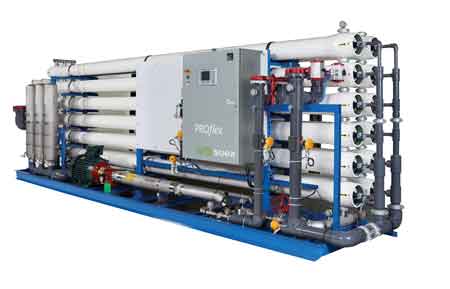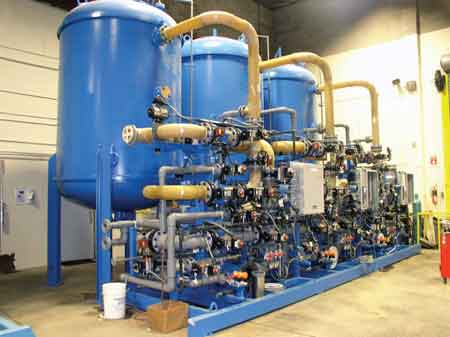New and pending PFAS regulation on drinking water is prompting wastewater treatment operators to take the initial steps.
By John Peichel
Per-and polyfluoroalkyl substances (PFAS) have been one of the biggest issues in drinking water treatment over the past decade. A class of man-made chemicals that have been manufactured since the 1940s, PFAS are used to make stain-resistant and non-stick products and are common in food packaging, outdoor clothing, carpets and different types of polishes, waxes and cleaning products. PFAS are widespread in the environment and mounting evidence has linked exposure to adverse human health effects.
PFAS are generally not biodegradable and persistent in the environment, including in fish, animals and humans. The compounds accumulate in living tissue and are, thus, bioaccumulative. It is estimated that nearly every one of us has some level of measurable PFAS in our blood and organs. The PFAS carbon-fluorine atom bond is one of the strongest in chemistry, which gives PFAS the name ‘forever chemicals.’

PFAS are increasingly prevalent in drinking water supplies and have come under heightened scrutiny by regulators. Under its PFAS Action Plan, the U.S. Environmental Protection Agency (EPA) recently proposed regulatory determinations for perfluorooctanesulfonic acid (PFOS) and perfluorooctanoic acid (PFOA) in drinking water. Likewise, several states have either proposed or adopted PFAS and PFOS limits. Although wastewater treatment providers do not currently face impending PFAS regulations, actions by regulators to reduce PFAS levels in drinking water are encouraging those on the wastewater side to begin planning. Conventional wastewater treatment does effectively remove PFAS even though the increasing PFAS concentrations in biosolids may eventually require further treatment before land application and low temperature incineration of theses wastewater biosolids.
Where wastewater streams could eventually come under regulatory scrutiny is cases in which discharges were found to impact the ability of a drinking water plant to meet PFAS requirements. With an eye to the future, wastewater treatment plants can be better prepared by developing a contingency plan, should drinking water levels compel higher levels of wastewater treatment. Wastewater operators exploring this route should be aware of key considerations when characterizing, designing, piloting and scaling up new wastewater treatment processes to remove PFAS.
Co-Contaminant Considerations
Generally, the solutions for addressing PFAS in wastewater will be the same as those being used to treat PFAS in surface and groundwater. These include absorption and capture, employing granular active carbon (GAC) and ion exchange (IX) technologies, as well as filtration and concentration using nanofiltration (NF) and reverse osmosis (RO).
But while wastewater operators may fully understand the merits of GAC, IX and high-pressure membranes, the complexity of dealing with co-contaminants when treating wastewater can be even more challenging than capturing the targeted PFAS materials. The difficulty relates to the potentially high levels of organics and various salts in wastewaters, which interfere with RO membranes or activated carbon and ion exchange processes. Addressing this complexity requires a comprehensive approach.
Since organics in wastewater act as a foulant on membranes and GAC media, secondary effluent wastewater frequently needs additional biological destruction—such as ozone or a bioactive filter. Following these treatments, the wastewater will be considerably lower in biological activity and can be more effectively treated for PFAS removal using RO and GAC.
Organic loading is less of a concern with IX since ionic adsorption is not influenced to the same extent by the presence of organics. However, treatment providers do need to be cognizant of inorganic salts such as calcium, magnesium, sodium and potassium, which interfere with the capacity of IX resins to be effective. Therefore, the decision to incorporate IX to treat PFAS in wastewater should depend on salt levels present.

Photos courtesy of SUEZ Water Technologies & Solutions.
The Benefit of a Holistic Approach
As with addressing any newly identified contaminant in wastewater, careful planning should be exercised when selecting an appropriate mix of treatment technologies for PFAS removal. Here, a holistic strategy is advised for considering all factors that can influence performance, costs and effectiveness. This is rooted in developing a thorough understanding of the water balance, co-contaminants, organic contamination, dissolved solids, and regulatory and discharge requirements. While the necessary technologies can be assembled, the optimal application of those technologies will, ultimately, depend on site-specific conditions, wastewater characteristics and treatment objective.
Feedwater Characterization
A cost-effective treatment strategy should begin with a feedwater characterization to establish PFAS levels and types. Knowing which specific PFAS are present—including both shorter-chain and longer-chain PFAS concentrations—will help decide which technologies are going to be the most effective. In addition to size, other molecular properties are providing better data in predicting the removal mechanisms of specific PFAS materials. An accurate wastewater profile is also critical for identifying concentrations and variability of specific organic and inorganic co-contaminants, which can potentially impact the go-to technologies for PFAS removal today.
Lab and Pilot Studies
A next level step includes lab and pilot studies that are necessary for gathering operational data. Lab studies—using small columns and/or membrane coupons—can be a quick and inexpensive approach if the wastewater is complex and unique. Pilot studies—which can last from three months to a year—are essential to evaluate performance, predict operational and lifetime costs, and identify the potential consequences of specific treatment technologies.
If IX is being considered, bench scale column loading tests can help determine capacity. If GAC is a potential option, the kinetic rates of reaction in the carbon vessel can be assessed. And with RO, pilot studies can help inform the fouling characteristics of the prevailing co-contaminants. Both lab and pilot studies should account for seasonal variation and performed frequently and of sufficient duration to collect an accurate assessment of the technology performance.
Final Disposal or Destruction
The fine level of filtration provided by RO effectively concentrates PFAS in a reject stream and since that waste is a potential source of pollution to the environment, consideration must be given to treating concentrated PFAS waste streams with GAC or IX to capture and remove PFAS chemicals. Once a GAC or IX media is full, the media and the PFAS captured in it are typically destroyed at very high temperatures through incineration, Although incineration is currently ranked as the best demonstrated available technology for disposal, spent GAC or IX media materials can also be landfilled to properly designed landfills with appropriate permits to receive PFAS waste.
According to the EPA, determining the appropriate method for ultimate disposal of PFAS wastes is a complex issue due to the volatility, solubility, environmental mobility and persistence of PFAS compounds. EPA is currently considering multiple disposal techniques, including incineration, to effectively treat and dispose of PFAS waste. The regulatory environment surrounding PFAS waste stream management is changing and what is approved today may not be in the future. To account for this uncertainty, wastewater treatment plant operators should adopt a staged implementation to manage shifting requirements. | WA
John Peichel is a Global Market Developer with SUEZ Water Technologies and Solutions. His 30-year career in water treatment has been on membrane technology where John has worked in applications, sales, engineering, product management, and research and development. His current responsibilities include the identification and early applications development of technology to solve customer problems and improve their processes. John’s experience includes reverse osmosis and nanofiltration membranes, their development, manufacturing processes and system design along with the wide variety of applications in treating water and processes. He can be reached at [email protected].
